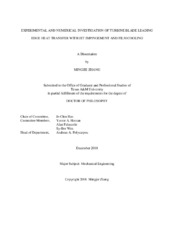| dc.contributor.advisor | Han, Je-Chin | |
| dc.creator | Zhang, Mingjie | |
| dc.date.accessioned | 2019-01-23T20:09:08Z | |
| dc.date.available | 2020-12-01T07:33:01Z | |
| dc.date.created | 2018-12 | |
| dc.date.issued | 2018-11-02 | |
| dc.date.submitted | December 2018 | |
| dc.identifier.uri | https://hdl.handle.net/1969.1/174466 | |
| dc.description.abstract | Modern gas turbines engines are designed with higher turbine inlet temperatures to increase the overall thermal efficiency and power output. Advanced cooling technologies are needed to protect turbine blades from hot gas and increase the lifetime of blades. The leading edge of turbine blades is subjected to very high heat loads. In order to reduce the temperature and increase the durability of turbine blades, film cooling and jet impingement cooling have been used in the leading edge portion. This study includes three topics: (1) influence of turbine blade leading edge profile on film cooling with shaped holes, (2) internal heat transfer of film-cooled leading edge model with normal and tangential impinging jets, (3) overall effectiveness of film-cooled leading edge model with normal and tangential impinging jets. The results provide baseline information for turbine blade leading edge cooling design and heat transfer analysis.
Topic 1 presents the turbine blade leading edge model film cooling effectiveness with shaped holes, using the pressure sensitive paint (PSP) mass transfer analogy method. The effects of leading edge profile, coolant to mainstream density ratio and blowing ratio are studied. Computational simulations are performed using the realizable k-ɛ turbulence model. Effectiveness obtained by CFD simulations are compared with experiments.
Topic 2 investigates turbine blade leading edge internal heat transfer for normal and tangential impinging jets with mainstream flow. Leading edge detailed internal heat transfer distributions are obtained. Experiments are carried out using transient liquid crystal method. CFD simulations using realizable k-ɛ (RKE) turbulence model are compared with experimental data.
Topic 3 studies turbine blade leading edge overall cooling effectiveness for normal and tangential impinging jets with mainstream flow. Pressure sensitive paint (PSP) technique is used to measure the adiabatic effectiveness. Liquid crystal technique is used to obtain the overall effectiveness. Conjugate heat transfer simulations using realizable k-ɛ (RKE) turbulence model are applied to calculate the adiabatic effectiveness and overall effectiveness. | en |
| dc.format.mimetype | application/pdf | |
| dc.language.iso | en | |
| dc.subject | Leading edge | en |
| dc.subject | Jet impingement | en |
| dc.subject | Film cooling | en |
| dc.subject | Conjugate heat transfer | en |
| dc.title | Experimental and Numerical Investigation of Turbine Blade Leading Edge Heat Transfer with Jet Impingement and Film Cooling | en |
| dc.type | Thesis | en |
| thesis.degree.department | Mechanical Engineering | en |
| thesis.degree.discipline | Mechanical Engineering | en |
| thesis.degree.grantor | Texas A & M University | en |
| thesis.degree.name | Doctor of Philosophy | en |
| thesis.degree.level | Doctoral | en |
| dc.contributor.committeeMember | Hassan, Yassin A. | |
| dc.contributor.committeeMember | Palazzolo, Alan | |
| dc.contributor.committeeMember | Wen, Sy-Bor | |
| dc.type.material | text | en |
| dc.date.updated | 2019-01-23T20:09:08Z | |
| local.embargo.terms | 2020-12-01 | |
| local.etdauthor.orcid | 0000-0002-0741-2679 | |


